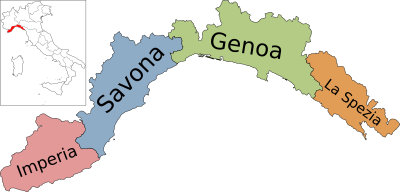Liguria
Liguria
Ligûria(Ligurian) | |
|---|---|
|
| |
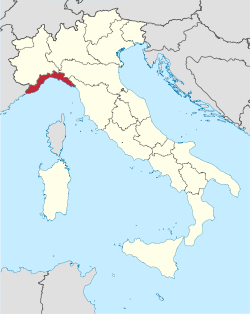 | |
| Country | Italy |
| Capital | Genoa |
| Government | |
| • President | Alessandro Piana(acting)[1](LSP) |
| Area | |
| • Total | 5,422 km2(2,093 sq mi) |
| Population (2017)[2] | |
| • Total | 1,557,533 |
| • Density | 290/km2(740/sq mi) |
| Demonym(s) | English:Ligurian Italian:Ligure |
| GDP | |
| • Total | €48.516 billion (2021) |
| Time zone | UTC+1(CET) |
| • Summer (DST) | UTC+2(CEST) |
| ISO 3166 code | IT-42 |
| HDI(2021) | 0.901[4] very high·10th of 21 |
| NUTS Region | ITC |
| Website | regione.liguria.it |
Liguria(/lɪˈɡjʊəriə/,Italian:[liˈɡuːrja];Ligurian:Ligûria,Ligurian:[liˈɡyːɾja]) is aregionof north-westernItaly;itscapitalisGenoa.Its territory is crossed by theAlpsand theApenninesmountain rangeand is roughly coextensive with the former territory of theRepublic of Genoa.Liguria is bordered byFrance(Provence-Alpes-Côte d'Azur) to the west,Piedmontto the north, andEmilia-RomagnaandTuscanyto the east. It rests on theLigurian Sea,and has a population of 1,557,533. The region is part of theAlps–Mediterranean Euroregion.
Etymology
[edit]The nameLiguriapredatesLatinand is of obscure origin. The LatinadjectivesLigusticum(as inMare Ligusticum) andLiguscus[5]reveal the original root of the name,ligusc-:in the Latin name -sc- was shortened to -s-, and later turned into the -r- ofLiguria,according torhotacism.CompareAncient Greek:λίγυς,romanized:Lígus,lit. 'a Ligurian, a person from Liguria' whenceLigustikḗλιγυστικήtransl. the name of the place Liguria.[6]The name derives from the ancientLigurespeople, although the territory of this people was much larger than the current administrative region; it included all of North-west Italy south to thePo river,and south-easternFrance.[citation needed]
Some scholars see a possible connection withOld European languages,as the formant -sc- (-sk-) is also present in names likeEtruscan,Euskadi(theendonymof the Basques), andGascon.Since these are all coastal regions, the shared formant may relate to a shared descent from pre-Indo-European, maritime peoples,[7][8]and/or the hypotheticalTyrsenianandVasconiclanguage families respectively. This argument is weakened, however, by the fact that the name Etruscan is a relatively lateexonymand the relevant endonym, used of the Etruscans themselves, wasRasennaorRaśna.(In Greek this mutated intoTursēnoiandTyrrēnoi;in Latin it becameEtruriaandTuscia,whence the name of the modernTuscanyorToscana.)[citation needed]
Geography
[edit]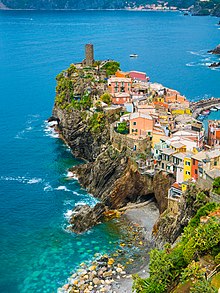
The narrow strip of land is bordered by thesea,theAlpsand theApennine Mountains.Some mountains rise above 2,000 m (6,600 ft); thewatershedline runs at an average altitude of about 1,000 m (3,300 ft). The highest point of the region is the summit ofMonte Saccarello(2,201 m; 7,221 ft).
Liguria is the third smallest Italian region afterAosta ValleyandMolise,but is also one of the most densely populated, with apopulation densityof 287 ab/km2,much higher than the national average, and is fourth place afterCampania,LombardyandLazio.However, there is much difference between inland mountain areas and coastal areas.
The region is crossed east to west by theLigurian Alpsand theLigurian Apenninesthat form an interrupted chain, but discontinuous in its morphology, with stretches where the Alpine/Apennine ridge is extremely compact and high aligning very high mountain groups (north to Ventimiglia, a series of massifs which became French after the Second World War, rises up to altitudes of 2700–3000 m) while in other stretches (for example in the hinterland of Savona and Genoa) the mountain barrier is not very high and deeply crossed by short valleys and passes that do not reach 500 m above sea level (Bochetta di Altare,Passo dei Giovi, Crocetta d'Orero).
The winding arched extension goes fromVentimigliatoLa Spezia.Of this, 3,524.08 km2(1,360.65 sq mi) are mountainous (65% of the total) and 891.95 km2(344.38 sq mi) are hills (35% of the total). Liguria's natural reserves cover 12% of the entire region, or 600 km2(230 sq mi) of land. They are made up of one national reserve, six large parks, two smaller parks and three nature reserves.
The continental shelf is very narrow and so steep it descends almost immediately to considerable depths along its 350-kilometre (220 mi) coastline. Except for thePortovenereandPortofinopromontories, the coast is generally not very jagged and is often high. At the mouths of the biggest watercourses are small beaches, but there are no deep bays and natural harbours except atGenoaandLa Spezia.
The hills lying immediately beyond the coast together with the sea account for a mild climate year-round. Average winter temperatures are 7 to 10 °C (45 to 50 °F) and summer temperatures are 23 to 24 °C (73 to 75 °F), which make for a pleasant stay even in the dead of winter. Rainfall can be abundant at times, as mountains very close to the coast create anorographiceffect. Genoa andLa Speziacan see up to 2,000 mm (80 in) of rain in a year; other areas instead show the normal Mediterranean rainfall of 500 to 800 mm (20 to 30 in) annually.
As of 2023, according to the report on land consumption of the Higher Institute for Environmental Protection and Research,Marcheand Liguria hold the Italian record for coastal overbuilding.[9][10]
History
[edit]
Prehistory
[edit]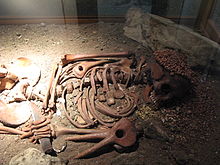
Evidence of human presence in Liguria dates back to prehistoric times. Near the port of Nice, in Terra Amata, traces of the oldest huts built by nomadic hunters, around300,000years ago, have been found. The stratigraphy showed different settlement periods, with the remains of oval huts with a central hearth, chipped pebbles, scrapers and captured animals such as wild boar, turtles, Merk's rhinoceros, southern elephants, aurochs and various birds. Traces of Neanderthal Man have been found near Loano. In the caves of Toirano, signs of frequentation dating back to the end of the Upper Palaeolithic are visible. Remains reminiscent of Cro-Magnon Man have appeared in the Balzi Rossi cave in Ventimiglia. At the Arene Candide there is evidence of Neolithic and epigravettian strata dating between 20,000 and 18,700 years ago, while in the caves along the Pennavaira stream, in the valley of the same name in the Ingauno area, human remains have been found dating back as far as 7,000 BC.
Copper begins to be mined from the middle of the4th millennium BCin Liguria with the Libiola and Monte Loreto mines dated to3700 BC. These are the oldest copper mines in the western Mediterranean basin.[13]
From the 2nd millennium B.C. (Neolithic), there are records of the presence of Ligurians over a vast territory, corresponding to most of northern Italy.
It is commonly thought that the ancient Ligurians settled on the Mediterranean coastline, divided in several tribes, from theRhoneto theArno(so we are told byPolybius), pushing their presence as far as the Spanish Mediterranean coast to the west and the Tiber to the south-east, colonizing the coasts of major islands such asCorsica,SardiniaandSicily.Numerous ceramic artefacts remain of them.[14]
The foundation of Genoa
[edit]The Genoa area has been inhabited since the fifth or fourth millennium BC.[15]In ancient times this area was inhabited byLigures(ancient people after whom Liguria is named). According to excavations carried out in the city between 1898 and 1910, the Ligure population that lived in Genoa maintained trade relations with theEtruscansand theGreeks,since several objects from these populations were found.[16][17]In the 5th century BC the first town, oroppidum,was founded at the top of the hill today called Castello (Castle), which is now inside the medieval old town. The ancient Ligurian city was known as Stalia (Σταλìα), referred to in this way byArtemidorus EphesiusandPomponius Mela;this toponym is possibly preserved in the name of Staglieno, some 3 km (2 mi) from the coast. Stalia had an alliance withRomethrough afoedus aequum(equal pact) in the course of theSecond Punic War(218-201 BC). TheCarthaginiansaccordingly destroyed it in 209 BC. The town was rebuilt and, after theCarthaginian Warsended in 146 BC, it received municipal rights. The originalcastrumthen expanded towards the current areas of Santa Maria di Castello and the San Lorenzo promontory. Trade goods included skins, timber, and honey. Goods were moved to and from Genoa's hinterland, including major cities likeTortonaandPiacenza.An amphitheater was also found there among other archaeological remains from the Roman period.
Roman times
[edit]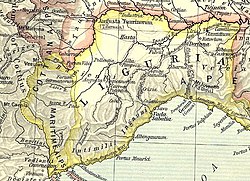
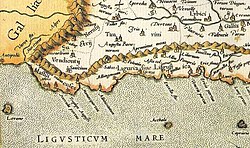
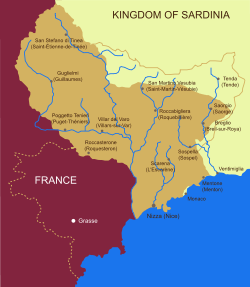

During the firstPunic War,the ancient Ligurians were divided, some of them siding withCarthage,others, including the inhabitants of Stalia (laterGenoa), with Rome. UnderAugustus,Liguria was designated aregion of Italy(Regio IX Liguria) stretching from the coast to the banks of thePo River.The great Roman roads (Aurelia and Julia Augusta on the coast, Postumia and Aemilia Scauri towards the inland) helped strengthen territorial unity and increase communication and trade. Important towns developed on the coast, of which evidence is left in the ruins ofAlbenga,Ventimiglia andLuni.In 180 B.C., the Romans, in order to dispose of Ligurian rebels in their seeking of theconquest of Gaul,they deported 47,000 LiguriApuani,confining them to the Samnite area betweenAvellinoandBenevento.[citation needed]
Middle Ages
[edit]
Between the 4th and the 10th centuries, Liguria was dominated by theByzantines,theLombardsof KingRothari(about 641) and theFranks(about 774). It was also invaded bySaracenandNormanraiders. In the 10th century, once the danger of pirates decreased, the Ligurian territory was divided into three marches: Obertenga (east), Arduinica (west) and Aleramica (centre). In the 11th and 12th centuries, the marches were split into fees, and then with the strengthening of the bishops' power, the feudal structure began to partially weaken. The main Ligurian towns, especially on the coast, became city-states, over whichGenoasoon extended its rule. Inland, however, fiefs belonging to noble families survived for a very long time.[vague]

Between the 11th century (when the Genoese ships played a major role in the first crusade, carrying knights and troops to the Middle-East for a fee) and the 15th century, theRepublic of Genoaexperienced an extraordinary political and commercial success (mainly spice trades with the Orient). It was one of the most powerful maritime republics in theMediterraneanfrom the 12th to the 14th century: after the decisive victory in theBattle of Meloria (1284),it acquired control over theTyrrhenian Seaand was present in the nerve centres of power during the last phase of the Byzantine empire,having coloniesup toBlack SeaandCrimean.
After the introduction of the title of doge for life (1339) and the election ofSimone Boccanegra,Genoa resumed its struggles against theMarquisate of Finaleand the Counts ofLaiguegliaand it conquered again the territories ofFinale,OnegliaandPorto Maurizio.In spite of its military and commercial successes, Genoa fell prey to the internal factions which put pressure on its political structure. Due to the vulnerable situation, the rule of the republic went to the hands of theVisconti familyofMilan.After their expulsion by the popular forces under Boccanegra's lead, the republic remained in Genoese hands until 1396, when the internal instability led the dogeAntoniotto Adornoto surrender the title of Seignior of Genoa to the king of France. The French were driven away in 1409 and Liguria went back under Milanese control in 1421, thus remaining until 1435.
Early modern
[edit]
The alternation of French and Milanese dominions over Liguria went on until the first half of the 16th century. The French influence ceased in 1528, whenAndrea Doriaallied with the powerful king of Spain and imposed an aristocratic government, which gave the republic relative stability for about 250 years.

Genoese explorerChristopher Columbus's speculative proposal to reach theEast Indiesby sailing westward received the support of the Spanish crown, which saw in it an opportunity to gain the upper hand over rival powers in the contest for the lucrativespice tradewithAsia.During his first voyage in 1492, instead of reaching Japan as he had intended, Columbus landed in theBahamas archipelago,at a locale he namedSan Salvador.Over the course of three more voyages, Columbus visited theGreaterandLesser Antilles,as well as theCaribbeancoast ofVenezuelaand Central America, claiming them for theSpanish Empire.
The value of trade routes through Genoa to the Near East declined during theAge of Discovery,when Portuguese explorers discovered routes to Asia around theCape of Good Hope.The international crises of the seventeenth century, which ended for Genoa with the 1684bombardmentbyLouis XIV's fleet, restored French influence over the republic. Consequently, the Ligurian territory was crossed by thePiedmonteseandAustrianarmies when these two states came into conflict with France. Austria occupied Genoa in 1746, but theHabsburgtroops were driven away by a popular insurrection. Napoleon's first Italian campaign marked the end of the oligarchic Genoese state, which was transformed into theLigurian Republic,modelled on theFrench Republic.After the union of Oneglia and Loano (1801), Liguria was annexed to theFrench Empire(1805) and divided byNapoleoninto three departments:Montenotte (department),with capitalSavona,Gênes,with capitalGenoaand the department of theApennines,with the capitalChiavari.
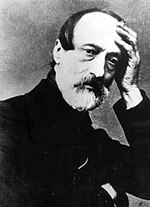
Late modern and contemporary
[edit]After a short period of independence in 1814, theCongress of Vienna(1815) decided that Liguria should be annexed to theKingdom of Sardinia.The Genoese uprising against the House of Savoy in 1821, which was put down with great bloodshed, aroused the population's national sentiments. Some of the most prestigious figures ofRisorgimentowere born in Liguria (Giuseppe Mazzini,Mameli,Nino Bixio). Italian patriot and generalGiuseppe Garibaldi,who was born in the neighbouringNice(then part of theSardinian state), started hisExpedition of the Thousandon the evening of 5 May 1860 from a rock in Quarto, a quarter of Genoa.
In late 19th and early 20th century, the region's economic growth was remarkable: steel mills and ship yards flourished along the coast fromImperiatoLa Spezia,while the port of Genoa became the main commercial hub of industrializing Northern Italy. During the tragic period of theSecond World War,Liguria experienced heavy bombings, hunger and two years of occupation by theGermantroops, against whom a liberation struggle was led—among the most effective in Italy. When Allied troops eventually entered Genoa, they were welcomed by Italian partisans who, in a successful insurrection, had freed the city and accepted the surrender of the local German command. For this feat, the city has been awarded the gold medal for military valour.
Demographics
[edit]
| Year | Pop. | ±% |
|---|---|---|
| 1861 | 829,000 | — |
| 1871 | 884,000 | +6.6% |
| 1881 | 936,000 | +5.9% |
| 1901 | 1,086,000 | +16.0% |
| 1911 | 1,207,000 | +11.1% |
| 1921 | 1,338,000 | +10.9% |
| 1931 | 1,423,000 | +6.4% |
| 1936 | 1,467,000 | +3.1% |
| 1951 | 1,566,961 | +6.8% |
| 1961 | 1,735,349 | +10.7% |
| 1971 | 1,853,578 | +6.8% |
| 1981 | 1,807,893 | −2.5% |
| 1991 | 1,676,282 | −7.3% |
| 2001 | 1,571,783 | −6.2% |
| 2011 | 1,570,694 | −0.1% |
| 2021 | 1,509,227 | −3.9% |
| Source:ISTAT2001 | ||
The population density of Liguria is much higher than the national average (300 inhabitants per km2,or 770 per mi2), being only less thanCampania's,Lombardy's andLazio's. In theMetropolitan City of Genoa,it reaches almost 500 inhabitants per km2,whereas in the provinces ofImperiaandSavonait is less than 200 inhabitants per km2.The Spanish travellerPedro Tafur,noting it from sea in 1436, remarked "To one who does not know it, the whole coast from Savona to Genoa looks like one continuous city, so well inhabited is it, and so thickly studded with houses,"[18]and today over 80% of the regional population still lives permanently near to the coast, where all the four major cities above 50,000 are located:Genoa(pop. 610,000),La Spezia(pop. 95,000),Savona(pop. 62,000) andSanremo(pop. 56,000).
The population of Liguria has been declining from 1971 to 2001, most markedly in the cities of Genoa, Savona and La Spezia. The age pyramid now looks more like a 'mushroom' resting on a fragile base.[19]The negative trend has been partially interrupted only in the last decade when, after a successful economic recovery, the region has attracted consistent fluxes of immigrants. As of 2008[update],the Italian national institute of statistics, ISTAT, estimated that 90,881 foreign-born immigrants live in Liguria, equal to 5.7% of the total regional population.[20]
Economy
[edit]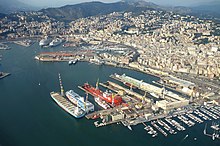
Ligurian agriculture has increased its specialisation pattern in high-quality products (flowers,wine,olive oil) and has thus managed to maintain the gross value-added per worker at a level much higher than the national average (the difference was about 42% in 1999).[21]The value of flower production represents over 75% of the agriculture sector turnover, followed by animal farming (11.2%) and vegetable growing (6.4%).

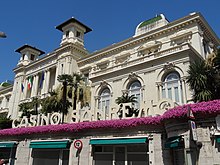
Steel, once a major industry during the booming 1950s and 1960s, phased out after the late 1980s crisis, as Italy moved away from the heavy industry to pursue more technologically advanced and less polluting production. So the Ligurian industry has turned towards a widely diversified range of high-quality and high-tech products (food, shipbuilding, electrical engineering and electronics, petrochemicals, aerospace etc.). Nonetheless, the region still maintains a flourishing shipbuilding sector (yacht construction and maintenance, cruise liner building, military shipyards).[21] In the services sector, the gross value-added per worker in Liguria is 4% above the national average. This is due to the increasing diffusion of modern technologies, particularly in commerce and tourism.
Transport
[edit]A good motorways network (376 km (234 mi) in 2000) makes communications with the border regions relatively easy. The main motorway is located along the coastline, connecting the main ports of Nice (in France), Savona, Genoa and La Spezia. The number of passenger cars per 1000 inhabitants (524 in 2001) is below the national average (584). In average, about 17 million tonnes of cargo are shipped from the main ports of the region and about 57 million tonnes enter the region.[21]ThePort of Genoa,with a trade volume of 58.6 million tonnes[22]it is the first port of Italy,[23]the second in terms oftwenty-foot equivalent unitsafter the port oftransshipmentofGioia Tauro,with a trade volume of 1.86 million TEUs.[22]The main destinations for the cargo-passenger traffic are Sicily, Sardinia, Corsica, Barcelona and Canary Islands.
Economical statistics
[edit]TheGross domestic product(GDP) of the region was49.9billion euros in 2018, accounting for 2.8% of Italy's economic output. GDP per capita adjusted for purchasing power was32,000euros or 106% of the EU27 average in the same year.[24]
The unemployment rate stood at8.3%in 2020 and was slightly lower than the national average.[25]
| Year | 2006 | 2007 | 2008 | 2009 | 2010 | 2011 | 2012 | 2013 | 2014 | 2015 | 2016 | 2017 | 2018 | 2019 | 2020 |
|---|---|---|---|---|---|---|---|---|---|---|---|---|---|---|---|
| unemployment rate (in %) |
4.8% | 4.8% | 5.4% | 5.8% | 6.6% | 6.4% | 8.1% | 9.8% | 10.8% | 9.2% | 9.7% | 9.5% | 9.9% | 9.6% | 8.3% |
Tourism
[edit]Liguria has many small and picturesque villages, 27 of them have been selected byI Borghi più belli d'Italia(English:The most beautiful Villages of Italy),[26]a non-profit private association of small Italian towns of strong historical and artistic interest,[27]that was founded on the initiative of the Tourism Council of the National Association of Italian Municipalities.[28]
Government and politics
[edit]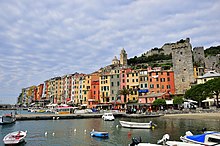
The politics of Liguria takes place in a framework of apresidentialrepresentative democracy,whereby the President of Regional Government is thehead of government,and of a pluriformmulti-party system.Executive poweris exercised by the Regional Government.Legislative poweris vested in both the government and the Regional Council.
The Regional Government is presided by the Governor, who is elected for a five-year term, and is composed of the President and the Ministers, who are currently 11, including a vice president.[29]
The Regional Council of is composed of 40 members and it is elected for a five-year term, but, if the President suffers a vote of no confidence, resigns or dies, under thesimul stabunt vel simul cadentclause (introduced in 1999), also the council will be dissolved and there will be a fresh election.
In the last regional election, which took place on 31 May 2015,Giovanni Toti(Forza Italia) defeated Raffaella Paita (Democratic Party), after 10 years of regional left-wing government byClaudio Burlando(Democratic Party).
At both national and local level, Liguria is considered a swing region, where no one of the two political blocs is dominant, with the two eastern provinces leaning left, and the two western provinces right.
Liguria is one of 20 regions (administrative divisions) of Italy.
Administrative divisions
[edit]Liguria is divided into four provinces:
| Province | Area (km2) | Population | Density (inhabitants/km2) |
|---|---|---|---|
| Metropolitan City of Genoa | 1,838 | 884,945 | 481.5 |
| Province of Imperia | 1,156 | 220,217 | 190.5 |
| Province of La Spezia | 881 | 222,602 | 252.7 |
| Province of Savona | 1,545 | 265,194 | 185.2 |
Culture
[edit]Cuisine
[edit]
Liguria is the original source ofpesto,one of the most popular sauces in Italian cuisine, made with freshbasil,pine kernels,olive oil,garlicandParmesan cheese.[30]
Seafoodis a major staple ofMediterranean cuisine,the Ligurian variety being no exception, as the sea has been part of the region's culture since its beginning.Ciuppinsoup is made from fish leftovers and stale bread, flavoured with white wine, onion, and garlic.[31]
Vegetables, especially beans, are important in Ligurian cooking.Mesciuasoup is made from beans, olive oil andfarro(old kinds of wheat includingemmer).[31]The Badalucco, conio and pigna beans are aSlow FoodPresidium.[32]
Ligurian pasta includestrenetteandtrofie,and the fresh pasta pockets calledpansòuti.[31]
Sports
[edit]The two main men's football clubs areGenoa C.F.C.andU.C. Sampdoria,which have played for decades inSerie A.They share theStadio Luigi Ferraris,and face each other in theDerby della Lanterna.The third most successful club isSpezia Calcio,which debuted in Serie A in 2020.
Pro Reccois a men's water polo club that has a record 33Serie A1titles and 9LEN Champions Leaguetitles.
TheMilan–San Remois one of the most prestigious one-day road cycling races in the world.
TheRallye Sanremoauto race was part of theWorld Rally Championshipfrom 1973 to 2003.
See also
[edit]References
[edit]- ^ANSA (7 May 2024)."Piana takes over as caretaker Liguria governor".ansa.it.Retrieved7 May2024.
- ^"Statistiche demografiche ISTAT".Demo.istat.it.
- ^"Population on 1 January by age, sex and NUTS 2 region",www.ec.europa.eu
- ^"Sub-national HDI - Area Database - Global Data Lab".hdi.globaldatalab.org.Retrieved5 March2023.
- ^"DicoLatin".DicoLatin.
- ^"Greek Word Study Tool".www.perseus.tufts.edu.
- ^Room, "Placenames of the World," 2006
- ^Marie Henri d'Arbois de Jubainville, Premiers Habitants de l'Europe (2nd edition 1889-1894)
- ^"Liguria, the future razed to the ground".5 December 2023.
- ^"I dati sul consumo di suolo".ISPRA Istituto Superiore per la Protezione e la Ricerca Ambientale(in Italian).
- ^"Balzi Rossi, one of the most important prehistoric shrines in Italy".27 March 2018.
- ^"The Young Prince of the Arene Candide".
- ^Figure 3. Monte Loreto. Fourth-millennium cal BC mineshaft (ML6)
- ^Zamboni, Lorenzo (2022)."Ceramiche d'impasto decorate in Cisalpina tra seconda età del Ferro e romanizzazione - appunti per una ricerca (PDF)".Milano University Press.
- ^The objects found during the works for the underground had been exposed in the exhibitionArcheologia Metropolitana. Piazza Brignole e Acquasola,held at the Ligurian Archeology Museum (30 November 2009 - 14 February 2010) ([1]ArchivedDecember 30, 2013, at theWayback Machine)
- ^Melli, Piera (2007).Genova preromana. Città portuale del Mediterraneo tra il VII e il III secolo a.C.(in Italian). Frilli.ISBN978-8875633363.
- ^Marco Milanese,Scavi nell'oppidum preromano di Genova,L'Erma di Bretschneider, Roma 1987on-linein GoogleBooks; Piera Melli,Una città portuale del Mediterraneo tra il VII e il III secolo a.C.,Genova, Fratelli Frilli ed., 2007.
- ^"Pero Tafur".depts.washington.edu.
- ^"Eurostat".Circa.europa.eu. Archived fromthe originalon 21 July 2011.Retrieved5 May2009.
- ^"Statistiche demografiche ISTAT".Demo.istat.it.Retrieved5 May2009.
- ^abc"Eurostat".Circa.europa.eu. Archived fromthe originalon 16 September 2008.Retrieved5 May2009.
- ^ab"Autorità Portuale di Genova — Traffico porto".Porto.genova.it. Archived fromthe originalon 2 December 2008.Retrieved26 December2008.
- ^"Inf_07_05_Statistiche dei trasporti marittimi 2002–2004"(PDF).Archived fromthe original(PDF)on 19 April 2012.Retrieved26 December2008.
- ^"Regional GDP per capita ranged from 30% to 263% of the EU average in 2018".Eurostat.
- ^"Unemployment NUTS 2 regions Eurostat".
- ^"Liguria"(in Italian). 10 January 2017.Retrieved31 July2023.
- ^"Borghi più belli d'Italia. Le 14 novità 2023, dal Trentino alla Calabria"(in Italian). 16 January 2023.Retrieved28 July2023.
- ^"I Borghi più belli d'Italia, la guida online ai piccoli centri dell'Italia nascosta"(in Italian).Retrieved3 May2018.
- ^"Regione Liguria – - sito ufficiale".Regione.liguria.it. Archived fromthe originalon 9 December 2002.Retrieved5 May2009.
- ^Della Gatta, Andrea."La Ricetta del Pesto Genovese"(in Italian). Consorzio del Pesto Genovese.Retrieved13 May2016.
- ^abc"The Food and Cuisine of Liguria".Made in Italy.Retrieved13 May2016.
- ^"Badalucco, Conio, and Pigna Beans - Presìdi Slow Food".Retrieved18 December2022.
External links
[edit]![]() Liguriatravel guide from Wikivoyage
Liguriatravel guide from Wikivoyage



